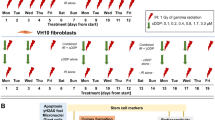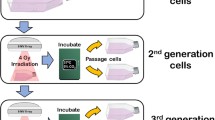Abstract
Previous studies have shown that the presence of epidermal growth factor (EGF) after irradiation enhanced the radiosensitivity of CaSki cells. To examine the role of EGF receptor density and related growth response in EGF associated radiosensitisation, four human squamous carcinoma cell lines were used. The total number of EGF receptors for HN5, A431, CaSki, and SiHa cells is 5.2 x 10(6), 1.6 x 10(6), 7.9 x 10(5) and 1.1 x 10(5) respectively, and the dissociation constant (Kd) for low affinity EGF receptors is 11.8, 3.8, 1.7 and 0.8 nM respectively. The Kd for high affinity receptors differs slightly among the four cell lines, 0.09 to 0.21 nM. EGF inhibited the growth of A431, CaSki, and HN5 cells, but stimulated the growth of SiHa cells. Due to the presence of 10 ng ml-1 EGF after irradiation, radiosensitivity enhancement associated with reduced shoulder size of the survival curve was observed. The extent of sensitisation was similar for A431, CaSki, and HN5 cells, with no effect on SiHa cells. At this concentration, EGF present during the clonogenic assay period after irradiation also reduced the plating efficiency (PE) of the monolayer cultures of A431, CaSki, and HN5 cells, but increased that of SiHa cells. The radiation response of mouse 3T3 cells (less than 5,000 receptors) was not sensitised by EGF. A similar level of radiosensitivity enhancement by EGF was observed for parental and conditioned A431 cultures. The conditioned cells were grown in 50 ng ml-1 EGF for 10 weeks and did not demonstrate growth inhibition and PE reduction by treatment with EGF. The EGF receptor numbers and binding affinity of these cells were the same as for the parental cells. The results from the conditioned cells support the hypothesis that EGF related radiosensitisation is EGF receptor density dependent.
Similar content being viewed by others
Author information
Authors and Affiliations
Rights and permissions
About this article
Cite this article
Kwok, T., Sutherland, R. Differences in EGF related radiosensitisation of human squamous carcinoma cells with high and low numbers of EGF receptors. Br J Cancer 64, 251–254 (1991). https://doi.org/10.1038/bjc.1991.286
Issue Date:
DOI: https://doi.org/10.1038/bjc.1991.286
- Springer Nature Limited
We’re sorry, something doesn't seem to be working properly.
Please try refreshing the page. If that doesn't work, please contact support so we can address the problem.




